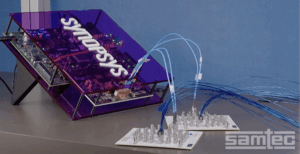Key Takeaways
- The sentiment that 'copper is dead' is often based on the belief that it's a choice between copper and optics, but both can be integrated effectively.
- Co-packaged optics (CPO) addresses copper's limitations over longer distances, enabling scalable, high-bandwidth links across data centers.
- The webinar, presented by Matt Burns, will explore the integration of copper and optics in advanced system designs and the flexibility of interconnect options available.

For markets such as data center, high-performance computing, networking and AI accelerators the battle cry is often “copper is dead”. The tremendous demands for performance and power efficiency often lead to this conclusion. As is the case with many technology topics, things are not always the way they seem. It turns out a lot of the “copper is dead” sentiment has to do with the view that it’s a choice of either copper or optics. In such a situation, optical interconnect will win.
But what if copper and optics could be integrated and managed together on one platform? It turns out there are many short-reach applications where copper is superior. The ability to achieve this co-technology integration at advanced 224G speeds was the topic of a recent webinar from Samtec. If you struggle with the negative ramifications of “copper is dead”, you’ll will want to see the webinar replay. More details are coming, but first let’s examine the path to smaller, denser, and faster with CPX, Samtec’s co-packaged copper and optics solution.
You can view the webinar here.
Who’s Speaking

The quality of a webinar, especially a live one is heavily influenced by the quality of the speaker. In the case of the upcoming event, everyone is in good hands. Matt Burns will be presenting. I’ve known Matt for quite a while. Samtec was an excellent partner of eSilicon back in the day, and I’ve attended many discussions and events with Matt. He has an easy-going presentation style, but under it all is a substantial understanding of what it takes to build high-performance communication channels and why it matters for any successful system design.
A quick summary of Matt’s background is in order. He develops go-to-market strategies for Samtec’s Silicon-to-Silicon solutions. Over the course of 25 years, he has been a leader in design, applications engineering, technical sales and marketing in the telecommunications, medical and electronic components industries. He currently serves as Secretary at PICMG. If it’s a close-to-impossible system design issue, Matt has likely seen it and helped to flatten it.
Some Topics to be Covered
Using all the tools and technologies available for any complex design project is usually the best approach. Matt discuses this in some detail, describing the situations where passive copper interconnect delivers the best result. Short reach is certainly one aspect that influences this decision, but there are other considerations as well.
For longer reach channels, active optical channels can be an excellent choice. The reasons to drive one way vs. another are not as simple as you may think and Matt helps with examples for various strategies.
The key point in all this is, what if you could deploy both copper and optical interconnect in a unified way? A mix and match scenario if you will. It turns out Samtec has been managing this kind of platform-level integration for about 15 years.
Getting into some specifics, the transition to 224 Gbps PAM4 signaling can strain copper interconnects due to reduced signal-to-noise rations and tighter insertion loss budgets. This usually limits reach to under 1 meter. Using co-packaged copper (CPC), this limit can be extended to 1.5 meters, enabling dense intra-rack GPU clusters while lowering system cost. But copper’s limitations over longer distances hinder inter-rack scaling.
Co-packaged optics (CPO) helps by integrating the optical engine within the switch silicon, enabling high-bandwidth, scalable links across racks. CPO overcomes copper’s physical constraints, reducing power and cooling costs, and unlocking scalable, efficient AI supercomputing fabrics that interconnect thousands of GPUs across data centers.
But what if you could have it both ways? Matt describes Samtec’s new strategy for advanced channel speeds that combines CPC and CPO to create a new category called CPX. This capability is delivered by Samtec’s Si-Fly® HD. A photo of the platform is shown on the top of this post.
Matt describes how this technology delivers the highest density 224 Gbps PAM4 solution in today’s market. He provides details about how the electrically pluggable co-packaged copper and optics solutions (CPX) are achievable on a 95 mm x 95 mm or smaller substrate using Samtec’s SFCM connector. The SFCM mounts directly to the package substrate and is pluggable with Samtec’s SFCC cable assembly or an optical cable assembly of your choosing.

Samtec has already worked with several high-profile system OEMs and IP providers to deploy this technology. Matt also talks about some of those achievements.
To Learn More
If you are faced with tough decisions regarding channel interconnect choices, you may have more options that you think. Matt Burns will take you through a new set of options enabled by Samtec’s new Si-Fly HD. The webinar’s full title is CPX: Leveraging CPC/CPO for the Latest Scale-Up and Scale-Out AI System Topologies. You can view a replay of this important webinar here.
Also Read:
Samtec Practical Cable Management for High-Data-Rate Systems
How Channel Operating Margin (COM) Came to be and Why It Endures
Visualizing System Design with Samtec’s Picture Search
Share this post via:





Comments
There are no comments yet.
You must register or log in to view/post comments.